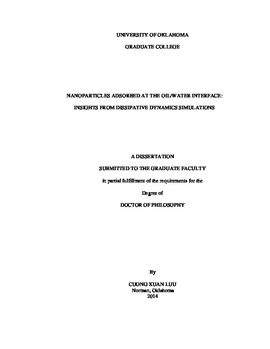| dc.description.abstract | Nanoparticles (NPs) can stabilize the so-called Pickering emulsions. These emulsions are used in many applications, including biofuel upgrading, material synthesis, food preservations and pharmaceutical processes. The fundamental understanding of the behavior of NPs adsorbed at oil/water interfaces is required to effectively utilize NPs for these and other applications. To this end, dissipative particle dynamics simulations were implemented and used herein. Various NP types, NP concentrations, and oil/water interfacial curvatures were systematically investigated. We found that the NP surface chemistry, NP shape, NP concentration at the interface, system composition, and curvature of the oil/water interface are all the key factors that can alter structural and dynamical properties of the NPs at interfaces. In some cases, evidence for emergent behavior has been documented. Among other interesting results, we found that when adsorbed at a flat oil/water interface, the averaged two-dimensional self-diffusion coefficient for a mixture of two types of spherical NPs of equal surface density is not a monotonic function of the NP composition. It was found that spherical Janus NPs are better at reducing interfacial tension than spherical NPs with homogeneous distribution of surface functional groups (homogenous NPs). For ellipsoidal Janus NPs it was found that the NP orientation with respect to the oil/water interface depends on the NP surface chemistry and aspect ratio. Ellipsoidal Janus NPs are more effective at reducing the interfacial tension than spherical NPs. An isotropic-nematic phase transition was observed for ellipsoidal Janus NPs with high aspect ratio as the NP surface density increased. Ellipsoidal NPs were found to yield isotropic, axial nematic, radial nematic, and isotropic phases with axial nematic domains, depending on droplet diameter, NP surface density, aspect ratio and surface chemistry. In addition, we found that the NPs behavior at curved interfaces strongly depend on the liquid type. It was found that NPs with high aspect ratios and few surface nonpolar beads, when adsorbed on a water droplet, have two equilibrium orientation angles. This observation becomes more interesting when one considers that the same NPs adsorbed on an oil droplet show only one preferential orientation angle. When coupled with appropriate experimental observations, our findings could be useful for the advancement of all those applications in which Pickering emulsions could be used. | en_US |
